App Store Optimization (ASO) – The Complete Guide

Originally published on March 2021, Updated on May, 2023
Before we start, did you mean to go to our ASO service page? Here you go – App Store Optimization Services
App store optimization tools show that there are over 5,000,000 apps in the app stores. That’s a lot of competition. Being present in the search results (read: #1 in the search results) is the safest and most cost-effective way to get users to download your app. This is where ASO comes into the equation.
ASO is essential for long-term mobile marketing results. While paid burst campaigns only bring in downloads for as long as the ads are running, ASO is all about constant maintenance.
Nobody wants their app to have only fifteen minutes of fame, right? It’s time to think ahead and plan for the long haul. So strap yourself in, and let us give you the ultimate tour of everything you need to know about app store optimization.
You’ll learn what app store optimization is, how it affects your app, best practices, what tools to use, and much more.

What is ASO and How Can It Help You?
ASO is the process of optimizing an app and its app store page for the app stores. Pretty self-explanatory, isn’t it? It works to improve your app’s visibility according to ranking factors determined by the app stores’ algorithms. A higher ranking leads to a higher search presence, which in turn leads to an increased number of organic downloads.
Looking to Achieve Mobile Hypergrowth?
Our ASO experts and Marketing specialists are here to help you achieve success.
Effective app store optimization (ASO) delivers more than just enhanced app visibility in stores. It ensures that your app store page is optimized to attract and convert users. This can be achieved with impactful screenshots, an informative app store video, or utilizing every available feature to showcase your app’s best features. ASO encourages visitors to convert at every stage of the user journey.
ASO will help you increase:
- App downloads
- Conversion rate
- App discoverability
- App revenue
- App ranking
- App reviews
- App ratings
How Does App Store Optimization (ASO) Work?
To give you an idea of how good ASO works, we’re going to take you on a little journey.
Let’s say you want to meditate for relaxation, but you’ve never tried it before, and you need some help. You realize there’s an app for that, so you open the Apple App Store or Google Play Store and search for the first relevant word that comes to mind: “meditation.” Next, thousands of apps appear in the results.
How do you know which one to choose?
You see that “Calm” appears in the #1 spot for the keyword “meditation” in the App Store, so you install it. Calm has had to work hard on its icon, name, app description, screenshots, and reviews to get there. This process is what App Store Optimization is all about.
No ads, no pop-ups, no invasive marketing. You just found and installed Calm because they were able to optimize their app offering for their targeted keywords.
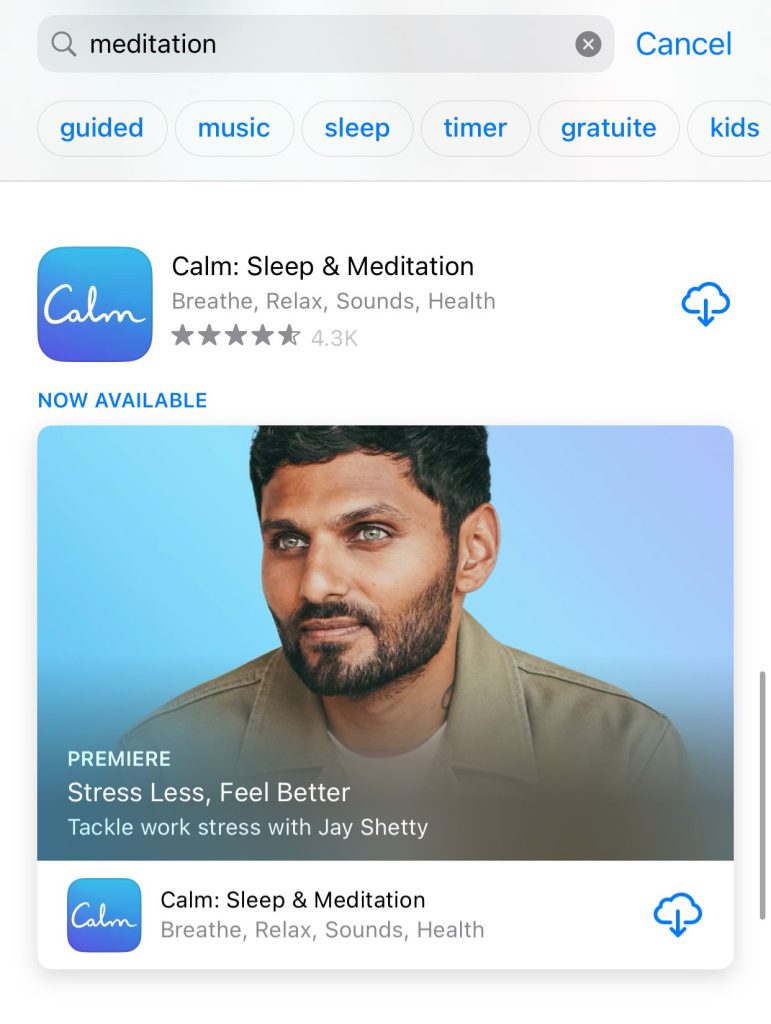
The likelihood is that you’ll only ever download an app that appears near the top of the search results, which is why ASO is so important.
Spoiler alert: when Calm was a client of ours, we helped them achieve:
- Hundreds of thousands of app reviews
- Millions of app installs and users
- Millions more in revenue
You can always read more about our clients and what we’ve helped them achieve here.
Looking to Boost Your App’s Visibility?
Our ASO experts and Marketing specialists are here to help you achieve success.
Top 10 App Store Optimization Ranking Factors
ASO leverages the algorithms at play in app stores. These algorithms analyze various ranking factors unique to each store to understand the quality and placement of your app. By optimizing your app’s store listing, its positioning can be improved in both search results and charts alike.
The app stores also use hidden factors based on the category or keywords, making it impossible to know every ranking factor. For example, there are 42 factors that help Apple determine search results rankings in the App Store.
Ultimately, if you work on optimizing your app according to the main ranking factors, your chances of achieving app store success will skyrocket.
Let’s go through them all below, in no particular order. Then we’ll cover the differences between Apple’s App Store and Google Play Store’s ranking factors.
1. App Downloads
The number of app downloads affects your ranking significantly, as we’ve mentioned before. But it’s not just about total numbers. Fast download rates can give your app’s ranking a welcome boost.
It’s worth noting that whether a download is organic or paid, the source doesn’t affect the ranking’s evaluation. With that in mind, there are two strategies to increase downloads:
Steady growth
- A long-haul strategy of slowly growing your download numbers that work best for small businesses (due to requiring less money to begin).
- The best ways to do this are with the help of an ASO agency, paid ads, and social media.
Burst campaigns
- A strategy of aggressively pushing your apps to the masses over a short time period with paid ads on social media.
- High budget = high reward. Burst campaigns require a big budget and the budget dedicated to prolonged media buying (that will last beyond the burst campaign’s 72 hours).
- This campaign style will win you hundreds of thousands of app installs quickly, e.g. in a couple of days.
- It has a snowball effect: as your app installs grow rapidly from the burst ads, your rank will rise in the app stores as a consequence, giving you more organic installs as well.
2. App Revenue
App stores profit by taking a cut of your app’s revenue. Because of this, they have exact data on how your app performs financially.
When your app’s revenue is high, so are their profits. This leads to incentives for higher-ranked apps; a win-win for both the app stores and app owners.

When it comes to revenue, trust factor is key. Apps with higher sales are clearly trusted by their users, which is taken into consideration by the algorithms.
An app’s revenue can come from either the initial download cost or any in-app purchases. App stores take all revenue into consideration, meaning that a free app with paid features can rank higher than a paid app.
3. User Experience
Your app’s user experience will greatly affect its ranking. If users only use it once or uninstall it straight away, often the result of a bad user experience, your ranking will likely decrease. How can you prevent this?
- Ensure the user experience is as smooth and compelling as it can be.
- Give users reasons to use your app every day by adding value.
- Encourage users to spend money inside your app.
All of the above will have a positive impact by reducing the churn rate and actively protecting your ranking position. Most users won’t return to your app if it’s difficult to use or doesn’t provide them with value.
Another top tip is to avoid overloading your onboarding process. Keep the user journey quick and smooth to make sure users see it through rather than abandon your app altogether. The more complicated you make the onboarding process and tutorials, the less likely you are to have a satisfied user.
User experience also refers to the positive app store experience you provide users with when they visit your app store page. Your ASO should create a compelling story using the right creatives, such as app store screenshots, icons, and videos, as well as the right strategic content with keyword research, titles, and descriptions.
Also, since the user experience varies between app stores, you need to factor this into your strategy. For example, where the App Store focuses a lot more on the screenshot gallery – it takes over 60% of the screen – Google Play Store only gives 25% of the screen to the gallery. Bear this in mind when you’re implementing text into your screenshots, as Google Play’s smaller size means that smaller text can often be unreadable.
4. App Reviews and Ratings
Both app reviews and ratings considerably affect your ranking and conversion rate. App stores want to provide their customers with the best experience, and part of that is offering the best quality apps. To judge which apps are good quality, the reviews and ratings are a great place to start. They act as social proof, demonstrating to users whether an app has helped other people or not and demonstrating to the app stores that your app is worthy of recognition.
If your app consistently receives bad reviews, the app stores will quickly remove it from their offering.
Around 59% of people check your app rating before even considering downloading your app. The question is, how do you get those ratings in the first place? A great way to yield high ratings from users is to present them with a “Rate Us” pop-up in your app. Both the timing and messaging of the pop-up are important for it to be successful. Anything too pushy or at a time that doesn’t make sense to the user will more likely deter them.
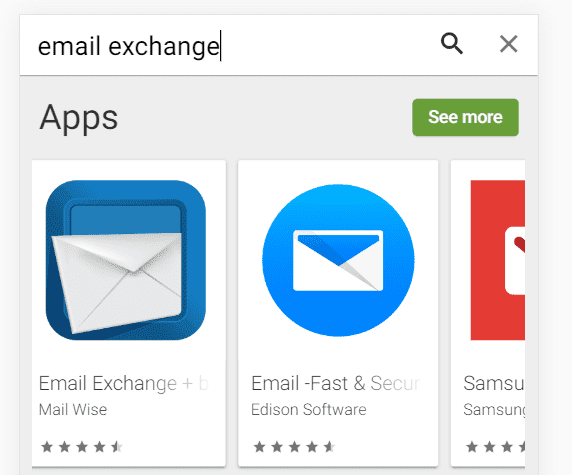
Take a look at the image above. What are the first things you see?
- App icon
- App title
- App brand
- App rating
Ask yourself: would you even consider downloading a one-star app? We can take an educated guess that the answer is no.
5. App Keywords
The keywords you use may be one of the most important ranking factors in ASO. Everything you do is related to the main keyword that users search for in the app store search bar.
Search traffic is often more targeted than browse traffic in the app stores, making these users the highest quality. They will either be looking for a brand directly or searching by intent – hoping to find a solution to a problem. Either way, their high-value presence elevates the importance of keywords in ASO.
Also, over 65% of all Apple App Store downloads come organically from people searching for different keywords. Considering the millions of searches users do every day, not getting your app featured in the first few results will significantly decrease your chances of app success.
It’s best to decide on keywords after conducting research on what’s most searched for (relevant to your app, of course).
There are various tools that can help you with your keyword research, such as AppTweak, AppFollow or App Radar. These can cost upwards of $10,000 a year, though, so enlisting the help of an agency who are already subscribed is often better value for money. Especially when you take into account their expertise and ability to best apply the data these tools provide to your ASO strategy.
6. ASO and App Updates
A more recent ranking factor in ASO is the “freshness” of the content. For example, an updated app description will receive a boost in ranking for its specific keywords because it reminds the app stores of its relevance. The same goes for constantly updating your app with new features, bug repairs, and information. Not only are the app stores being reminded of your relevance, but they’re also seeing that you care about improving the user experience.
Most ASO experts recommend pushing small updates frequently to improve your ranking. That’s why at Moburst, we work with our clients on a rolling basis to update their ASO each month. This also allows us to stay on top of what’s working, and what’s not, and changing trends in our dynamic industry.
7. App Retention Rate
In the first thirty days following each install, your app gets scanned and monitored for retention problems. The number of uninstalls your app receives can have a detrimental effect on your position in the app stores and your chances of being featured in category charts.
As we touched upon above, ensuring users don’t uninstall your app too fast is essential for maintaining a high rank. However, this becomes especially important if you just ran a burst campaign because of the sheer volume of installs that will be coming your way and, therefore, the sheer volume of uninstalls that could follow. This could lead to a super high churn rate and have a detrimental effect on your app’s ranking.
How can you prevent users from churning too fast?
- Offer free features inside the app.
- Offer special experiences and gifts within the first few days of a user installing the app.
- Provide constant value. This sounds simple, but it’s a lot easier said than done.
Offering special experiences and gifts is a strategy that works best for mobile games. However, there are always opportunities for any type of app to offer free features and provide constant value to increase your app retention rate.
8. App Localization
Not everyone speaks the same language, so one size does not fit all in ASO. Translating and localizing your app for different countries can boost your ASO. The app stores would rank your app higher if it’s translated for users in a specific region.
Your conversion rate will also skyrocket if you work to translate your app store screenshots. Uber did this for the Japanese market. Not only did they update the language, but they also used maps of Japanese cities for the screenshots.
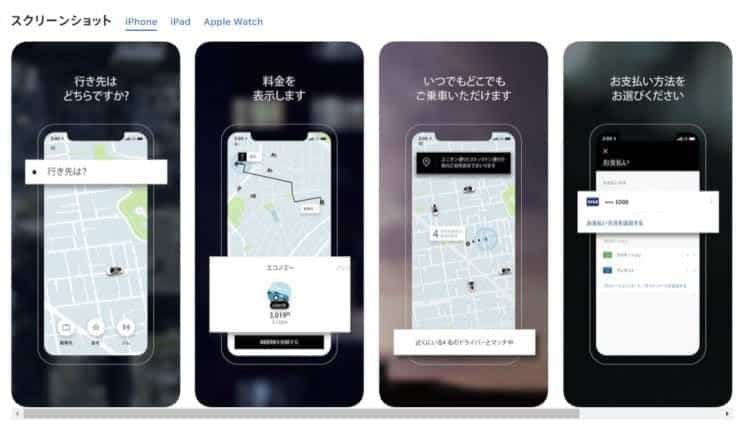
Every geographic location has its own cultural references, so it’s vital to conduct separate keyword research based on the country’s specific characteristics, trends, and language. The right approach can even differ between countries with the same language.
9. App Title
Optimizing your app name around a specific keyword can increase organic downloads by over 10%. When aiming for millions of downloads, that 10% can be a game-changer.
Most app stores have character limits for the app name/ app title, and they differ on each. For example, Apple’s App Store allows up to thirty characters, and Google Play Store allows up to fifty. We recommend using your full allowance to maximize the ranking opportunity so long as you’re using valuable, searchable keywords.
Even Amazon integrated the generic keyword “shopping” inside their app title for this exact purpose.
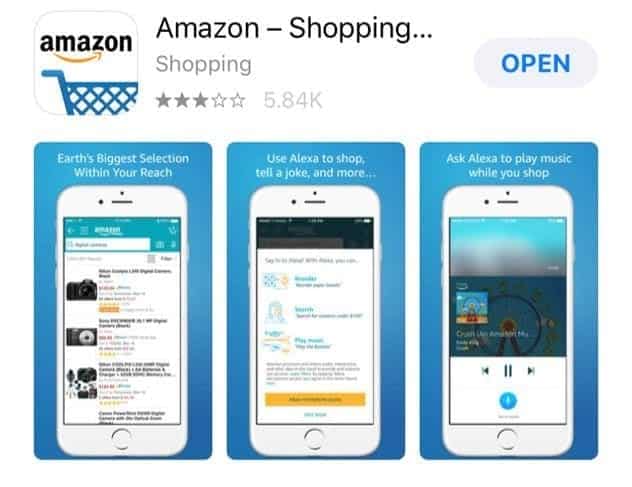
10. App URL
Integrating your main keyword in the app’s URL can greatly affect your app’s ranking. This is something to consider when you’re at the pre-launch stage. In Google Play, once you’ve published your URL you can’t update it.
Fun fact: a Mario game managed to rank for the ZARA keyword because of the way they integrated the keyword “Zara” into their app’s URL. That’s kind of crazy, right? This shows the power of integrating keywords into your URL.
Are you in need of an ASO Agency?
Our ASO experts and Marketing specialists are here to help you achieve success.
Best Ranking Factors: Apple App Store vs. Google Play Store
Each app store has its own specific guidelines and algorithms. So far, we’ve talked about general ranking factors, now it’s time to get specific.
Screenshots, app preview videos, and icons (creative assets) are some of the most important features for iOS users. Google Play Store borrows a lot from SEO.
Discover the top ranking factors for the App Store by referring to this guide and explore this guide to find out everything you need to know about Google Play Store’s Ranking Factors. Both of these resources can help you improve your mobile app’s performance, visibility, and ratings.
How Do I Optimize My App for The App Stores? Crafting an Effective App Store Optimization Strategy
We’ve already dived into what app store optimization is, what factors influence it, and what you need to track in order to achieve success. Now let’s talk about execution with a step-by-step guide.
1. Choose The Right Category and Audience
Inevitably, if you position your app in the gaming category when it’s really a cooking app, you’re going to be targeting the wrong users. However, in most cases, the difference between categories is more subtle. You might enter your app into the Health & Fitness category when it would, in fact, work better in the Lifestyle category, for example.
The best way to choose your category, if it’s not clear, is by analyzing your competitors. It’s not only important to appear in the app store search results; appearing near the top of category charts can bring many downloads too.
Android Users vs. iOS Users
It may surprise you to realize there’s a big difference between Android and iOS app users, given that they both come to the app stores with the same goal in mind – to find or download an app.
However, the key difference between the two lies in the fact that while Android users account for the majority of app installs, iOS users account for the majority of mobile revenue. Read: iOS users tend to be a higher value for a business.
Without delving too much into the exact demographics of each, we’ll remind you to take into account the data surrounding iOS and Android users when establishing your strategy. Knowing which devices the biggest spenders are using can make a difference.
Take note, also, that the market share of Android and iOS users differs from country to country. For example, in North America, iOS is the clear winner, whereas in Europe, Android accounts for the majority of operating systems.
2. App Store Keyword Research
The first and most important aspect of your ASO efforts is researching and deciding on what app store keywords to use. A wrong keyword can cause you to lose thousands of installs or waste your entire marketing budget.
While conducting your app store keyword research, we recommend that you follow these steps:
1. Brainstorm keyword variants and use tools in order to validate them and accumulate more.
2. Acquire insight from users.
3. Analyze your competition and see what keywords they’re targeting. Tools can help you access this information.
Think about what words best represent your app’s features, but also what words are being searched for in the app stores in relation to your offering or app category. It doesn’t matter what you think represents your app’s features if nobody is searching for that term; a combination of both is needed to be successful.
Don’t try reinventing the wheel here. If your competitors are having success then you should take a leaf from their books.
We mentioned ASO tools to consider further above, from AppTweak to AppFollow. While features differ between them all, they generally offer the ability to compare apps, view timelines, keyword rankings, and much more.
We recommend using multiple tools to compare the data. The tools can help you compile a list of relevant keywords and then decide on what you’ll rank for depending on search volumes, app relevancy, and user intent.
Keywords can either be a single word or a phrase. A worthwhile tip for the App Store when using long-tail keywords, or keyword phrases, is to separate the keywords with commas when inserting them into the keyword field. Keyword phrases often have lower difficulty scores, meaning a higher chance of ranking for them. For example, when inserting the long-tail keyword “healthy meal plan” into the keyword field, you’d insert it like this “healthy,meal,plan”.
By separating each word with commas, you’re taking advantage of Apple’s algorithm that automatically makes different combinations using the separate words.
Often, there’s little difference between using a keyword in its singular or plural form. The chances are you’ll still gain visibility for the one you don’t use, which is why it’s not important to use both.
There are also words that we deem wastes of space. Avoid using words such as “free”, “best”, “app”, “iPhone” or any other generic word that doesn’t reveal anything unique about what your app offers.
3. Most Valuable Places for Keywords
After you’ve decided on the main keywords to focus on, you need to integrate them into all of the available places. For example, the app title has the highest weight for the algorithms on both app stores, so using your most relevant and high-volume keywords there is advisable. You’re more likely to rank for a keyword used in the title than in the long description.
When integrating keywords into the app name, subtitle, and short description, the minimal character count is one of the driving forces behind knowing which words to prioritize. There are certain words to avoid that we deem a waste of space, such as “free,” “app”, “best,” and “new.” They don’t add value partly because they’re not informing users about what your app truly offers and partly (in Apple-related cases) because all apps are indexed for them anyway.
What’s more, for iOS, you should avoid repeating keywords in the app title and subtitle since keyword density doesn’t contribute to app visibility. Repetition won’t bring added value and instead takes up valuable space that could be dedicated to another keyword.
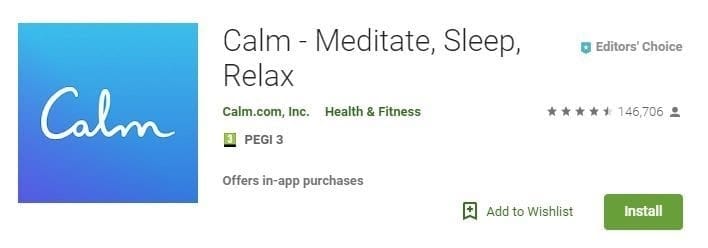
Our client, the meditation app Calm, increased its conversion rate, position, and number of installs by integrating its three main keywords inside its app name. They’ve also named their app after a keyword people search for.
The app’s main keyword can be used inside the URL as well in order to boost ASO efforts. While some experts argue that the URL is less relevant nowadays, Nintendo’s Mario game managed to rank for the ZARA keyword because of the way they integrated “Zara” into their app’s URL. We don’t recommend trying this method anymore – using the brand name of competitors’ is now a violation of Apple’s Guidelines – but it does indicate what’s possible when keywords are inserted there.
While it’s not a recommended strategy for most companies, you can also integrate keywords into your developer name. This is one of the best solutions for small indie companies that care less about the brand’s presence in the app stores.
4. App Store Descriptions
You’ve got long and short descriptions, and on iOS, you even have subtitles. Make sure to integrate your main keywords into each of these sections.
Within the descriptions, it’s also best to present your app in a coherent and relevant format. Stuffing the description with keywords just for the sake of ASO won’t help you. In fact, the app stores have been known to crack down on what is called “keyword stuffing” and penalize apps for doing it.
On Apple’s App Store, you can integrate keywords directly inside the keyword field.
You have 100 characters, and we recommend using them all. Spare characters is a wasted opportunity to rank for keywords.
5. Improve Your Conversion Rate
There’s no point bringing 10,000 users to your app page if only 100 of them install your app. If that’s the case, your ASO needs some serious improvements.
Your app store conversion rate is affected by the following:
- App Icon
- App Name
- App Store Description
- App Store Preview Video
- App Store Screenshots
- And more
Your app icon is the first image people see when searching for an app. It needs to be colorful and relevant enough to catch their attention. If you’re representing a big brand, you can capitalize on your brand awareness and use your own logo. If you’re a startup or smaller company, create an app icon that’s similar to niche icons.
Take a look at the icon our once client Mailwise had. You know from the first moment you see what the app is.

We’ve already covered how important it is to integrate your main keywords into your app name and description. Don’t forget to also think about the sales part. You need to create conversion-oriented copy. Integrate call-to-action sections, present your app’s benefits and top features, and appeal directly to your target user’s needs.
In terms of app store demographics, we can give you two top tips to perfect your targeting:
- A/B Testing
- Research
A/B testing can be done through platforms such as SplitMetrics and Storemaven. A/B testing your app store screenshots, for example, allows you to see which set performs best according to your app’s specific audience. It takes the guesswork out of the equation.
Working on your app store screenshots can do wonders for your conversion rate. Put your best foot forward in the first two screenshots, as these are the ones visible before scrolling and offer the best chance to make a good impression. Make sure the first two screenshots convey your number one message.
You can check out our best practices for creating the best conversion-oriented screenshots here. There are many factors to consider, such as app store regulations, landscape vs. portrait, or appropriate font size.
We helped Mailwise increase its app page conversion rate through A/B testing their app store screenshots. Here’s a before and after of what we did for them:
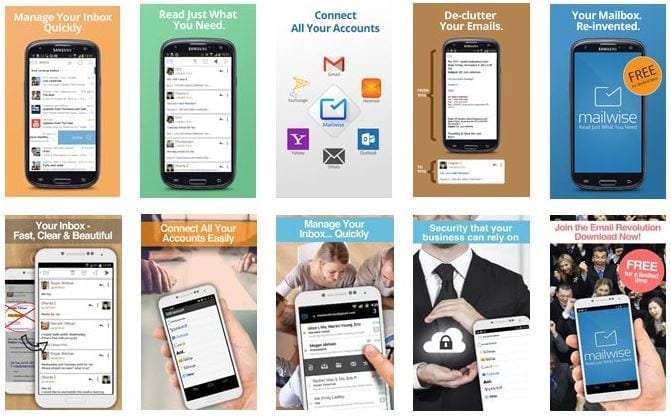
The same thing goes for app store preview videos. It needs to be as relevant as possible, show how your app works, present its best features and be relatable. The majority of users will drop off in the first few seconds, so make sure you kick off with a bang.
Also, you should know how your target audience responds to the video. Are users in your app category open to watching app store videos? If so, how long do they watch for? Do they often convert as a result? Knowing your audience is crucial every step of the way, and it’s no different here. On average, iOS users watch 6-8 seconds of a video vs. 4-5 seconds for Google Play users.
What ASO Marketing Metrics and KPIs Should You Follow?
There’s no point investing in ASO if you don’t know what you’ll earn back. So, you need to make sure to carefully monitor your results, just like any other marketing you invest in. If you keep a close eye on it, you can adjust your strategy, budget, and the overall quality of your ASO.
App Downloads
All ASO and general mobile marketing efforts are related to one main objective: get as many app downloads as possible.
The best way to analyze this KPI is to understand the following:
- Numbers
- Mediums: this is super valuable as knowing what percentage of your installs come from paid vs. organic efforts can help you to decide which mediums are more profitable for you and, therefore, worth more future investment. There’s no point in investing in email marketing, for example, if you get almost no returns from it, right? Mediums are broad analytics categories that can be split into: Organic, paid, referral, and custom campaigns.
- Sources: this is a little more in-depth, showing where the user came from exactly. Was it a website? The app store search bar? Or a specific Google Ads campaign? Looking into every install source will help you better understand how to manage your budget.
- Time frames.
You need to ensure you know how many downloads you’re getting at every moment of your ASO campaign.
Active Users and Stickiness
Users that install your app but never open it won’t help you in the long run. The only way to generate revenue from a user (especially for free apps or mobile games) is to have them be active in your app.
In order to measure active users, you need to understand when the users open the app and use it.
The main metrics here are:
DAU: daily active users. This is calculated with the number of people that log into your app at least once daily.
MAU: monthly active users. This is calculated with the number of people that log into your app at least once monthly.
Stickiness is earned by dividing DAU/ MAU. The higher the number, the better.
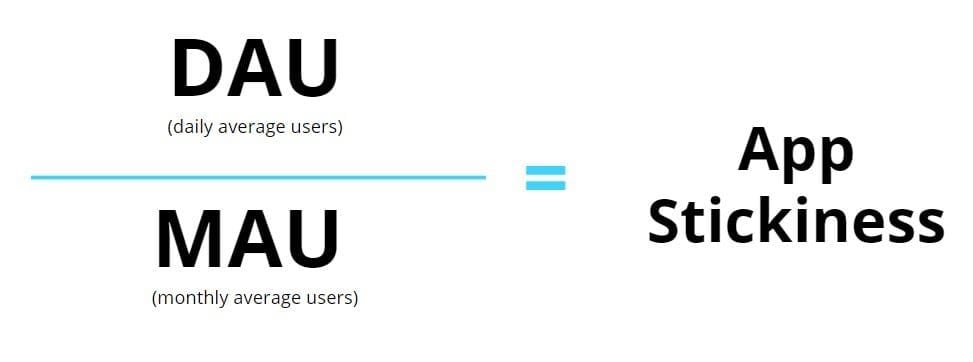
Retention Rate
When working on your ASO strategy, you need to consider how the app interacts with the user as well. It’s not only about bringing large numbers of users to it; they need to stay, use it and convert it into revenue.
The app’s retention rate allows you to calculate how many users actually stay in the app. It’s calculated by dividing the number of installs in a day by the number of active users. If your numbers are low, it means that people don’t get enough value from your app, and something must be changed.

Churn Rate
This is the exact opposite of the retention rate. One of the least desired results in any app store optimization campaign is a high churn rate.
The churn rate represents the percentage of users who stop using your app within a certain time frame. If you bring in 10,000 users and 50 of them uninstall the app in a given time frame, you can consider that you have an app churn rate of 0.5%. This is good.
However, usually over 70% of all app users churn in 90 days or more. You need to think about how to avoid this.
If a high percentage of your users churn in the first few days after downloading your app, it’s a problem that will negatively impact your ranking. Your ASO strategy would need to target the issue.
Conversion Rate
The conversion rate refers to the percentage of people that make a certain action from the total of all your users.
For example, if you have a free app selling subscriptions, or a mobile game selling in-game loot, your conversion rate can be calculated as non-playing users/playing users in a certain timeframe. Like this:

Of course, there are multiple things that can also be tracked beyond sales.
Average Revenue Per User (ARPU)
App revenue is mostly a numbers game. You work on boosting every percentage, hoping to increase the total revenue of your app.
This is one of the most important ASO-related KPIs. It works by dividing the number of users by the total revenue generated in a certain time period.

By knowing this number, you’ll be able to work on predicting and planning future marketing budgets. You can make statistically accurate revenue predictions based on future user growth.
Cost Per Acquisition (CPA)
This metric is what differentiates the best mobile marketing agencies from the mediocre. Anyone can bring installs to an app, but if you pay $5 per install instead of $0.25, you’re doing it wrong.
Knowing how much money you need to spend in order to bring a user to your app is one of the most important metrics in the mobile marketing industry as a whole. That’s where the true skill lies.

App Acquisition Costs
It’s also extremely relevant to know how much each traffic source costs. Sometimes, Facebook ads can bring cheaper users than other platforms. Yet, their ARPU can be significantly lower. This metric must be used in correlation with the others.
Return On Investment (ROI)
We’re talking about profits now. How much money do you spend, and how much money is your app making?
If you’re interested in scaling your app and bringing investors on board, this is one of the most important metrics. They’re going to be interested in the profitability of your money-making machine, after all.
Lifetime Value (LTV)
For many apps and mobile games, a user will convert multiple times. They may be paying for a subscription service once a month or maybe for multiple in-game items.
No matter the process, it’s extremely important to understand how many times a user converts and what the average revenue you can expect from them is.

Knowing this value, the churn rate, and your marketing capabilities, you’ll be able to predict the revenue your app will make in the future.
App Store Ratings and Reviews
As mentioned already in this article, app store ratings and reviews affect your position on the app store and, therefore your conversion rate. If you don’t take into consideration what users are saying about you, your app’s chances of success are slim.
Make sure to track each review and analyze your rating from one time period to the next. By doing this, you can correlate your rating to certain changes you made inside the app. If you removed a feature and your rating fell, bring that feature back.
Also, the review system is a great place to find ideas for new features and get feedback from your avid users.
Are You Ready to Take Your App to the Next Level?
Our ASO experts and Marketing specialists are here to help you achieve success.
Final Words
At Moburst, ASO is in our DNA. We provide top-tier app store optimization services and educate entrepreneurs, developers, and app marketers on optimizing app store performance to perfection.
We recognize that ASO is an ongoing process that requires constant maintenance, which is why it’s important to keep on top of changing regulations, trends, and data. At Moburst, we’re always up-to-date on Google Play Store and Apple App Store’s algorithms. An app’s success requires more than creative thought processes. It requires constant monitoring and performance analysis too.
After driving traffic to your app store page, through either organic or paid means, it’s imperative to maximize conversion rates and secure a loyal user base. With just a click, users can choose to download or pass on your app. That’s why your app page must be strategically designed and visually-appealing to ensure a decision that typically takes only a few seconds is in your favor.
If you’re a business owner or app marketer responsible for an existing or upcoming app, feel free to contact us. We’ll make sure to skyrocket your app ranking and boost your app downloads and revenue. Feel free to also check out our clients from throughout the years.
App Store Optimization FAQs (Frequently Asked Questions)
App Store Optimization (ASO) is the process of optimizing mobile apps to rank higher in an app store’s search results. The higher your app ranks in an app store’s search results, the more visible it is to potential customers. ASO includes optimizing various elements of your app such as title, keywords, icon, description, and screenshots to make it more attractive to users and increase downloads. ASO helps improve the visibility and discoverability of your app in the app store, leading to an increase in organic downloads and ultimately improving your app’s overall success.
App Store Rankings refer to the position of an app in the search results of an app store for a particular keyword or category. The higher your app ranks in the search results, the more visible it becomes to potential users. App store rankings are important because they play a significant role in driving organic downloads. Users tend to download the apps that appear at the top of the search results since they assume that these apps are the most relevant and trustworthy. Therefore, improving your app’s ranking in the app store can lead to increased visibility and more downloads, which can ultimately lead to the success of your app.
There are many ways to optimize an app, including incorporating the right keywords into your metadata, A/B testing screenshots to ensure you choose ones that convert, prioritizing a positive in-app user experience, encouraging positive ratings and reviews, and plenty more. We talk all about it in more depth here.
App store optimization requires constant maintenance, so updating your app and its app store page often is the key to success. This could be anything from updating the app description with new keywords or adding an app preview video to your app page to fixing bugs in the app itself or addressing the issues presented in app reviews.
65% of users find an app through organic search. ASO increases your app’s visibility in the app store search results, so to get yours anywhere near the top spot, you need to make it a priority. Remember, you’re competing with millions of other apps here, so you shouldn’t go cutting corners.
Being a mobile marketing agency with a pioneering ASO department, we’ve tested a high number of tools over the years. It’s safe to say we’ve loved some and hated others. We also noticed that many app store optimization tools give different data. Because of this, we researched the relevancy of various tools and decided on using less, more powerful tools. You can always check out our research and list in our ASO tools article.
Some of the most comprehensive tools out there are AppTweak, Sensor Tower, MobileAction, AppFollow, and App Radar.






